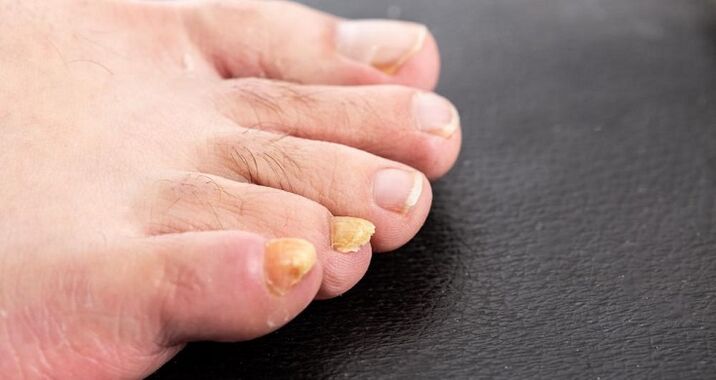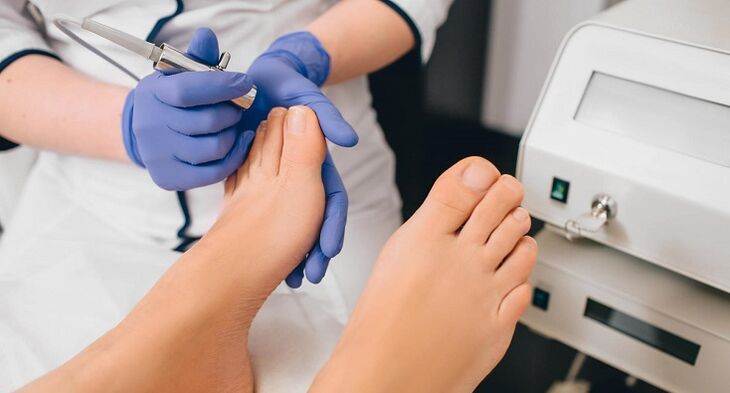Nail fungus is a disease caused by a variety of pathogens. To destroy it, you need to make a diagnosis to identify all the characteristics of the disease. What is the reason for it? There are many reasons for fungal infection, which is a prerequisite for its appearance.

The genetic cause of the disease
For many years, fungal spores can be found on various surfaces. A person often encounters pathogenic microorganisms, but infections do not always occur. In order for nail fungus to appear, there must be a regulatory factor. The infection must have the conditions for development. Scientists have conducted a lot of research on the pathogenesis of the disease.
Facts have proved that one of the factors that cause fungal infections is genetic predisposition. According to research, fungal diseases most often occur in people whose relatives suffer from similar diseases. The progression of the disease will affect the genetic level.
Interesting cases of infection that occurred while living together. Close contact is most susceptible to fungal diseases. However, it usually develops in one family, but does not affect another family. The disease usually occurs in people whose genes are most similar to the person who originally had the fungal disease. According to all these data, relative to the closeness of genetic connection, the closeness of contact is less important for infection.
Symptoms of fungal disease
Nail fungus manifests itself in different ways at different stages. Usually, fungal infections begin in the interdigital space. At this time, there are:
- The appearance of bubbles;
- Redness of the skin;
- Itching.
If there is no treatment at this stage, the disease will begin to affect the nails. In this case, the following signs are detected:
- The nail plate is dim and therefore loses transparency;
- White streaks and spots appear;
- Uncomfortable feeling.
It is best to treat at this stage because it will reduce the cost of treatment. In order to eliminate microorganisms, external preparations are sufficient: ointments, varnishes. If no action is taken, nail fungus will worsen. This is manifested by the following symptoms:
- Thinning or thickening of nails;
- Peeling off the nail plate;
- Leave the nail bed
- Unusual color of the board: it becomes white, yellow or black;
- In the final stage, the nails will really chip, collapse, and an unpleasant smell may appear.
Mycosis does not only exert its pathological activity on the toenails. The inflammatory process occupies the entire foot.
She started blushing and peeling. The patient feels itching, which gets worse during the worsening period. The presence of characteristic signs allows you to determine the disease during the initial examination.

Types of fungal infections
Nail fungus is divided into several types according to the microbiota caused by it. Mainly divided into three groups:
- Dermatophytes.The most common situation. In 95% of cases, this group is the cause of fungal diseases;
- Candida.These yeast-like microorganisms help thin the nail plate. She started to turn yellow and fell behind her bed. The lesions start from the nail folds. As the disease progresses, swelling will appear. In some cases, pus discharge may occur. The skin of the plate stopped growing, so it turned brown. The nail is about to break. These microbiota usually develop in women. At-risk groups-housewives who often deal with household chemicals. It will positively affect the skin, thus opening the "door" for infection;
- Moldy species.These microbiota cannot penetrate deep into the nail plate. This does not completely destroy it, but the disease is full of other effects. The color of nails varies greatly. It can be black, blue, and green.
Treatment is based on the microbiome, because different pathogenic microorganisms respond differently to drugs. Sometimes, when the diagnosis is made, three types of fungi are detected. In this case, complex treatment will be required.
Fungal form
The disease has different stages and different types of lesions:
- Positive nutrition.The color of the nail plate will change. It will turn yellow and lose transparency. White and yellow streaks or dots appear. The difference between diseases is that the nails do not undergo significant deformation. Sometimes, it even retains its former glory;
- Shrinking.The nails become thinner and lose their luster completely. There are obvious white and yellow stripes, and the dots represent special infected lesions;
- Hypertrophy.The sector has changed a lot. Signs of thickening and crushing were observed. It becomes porous. Obvious pain syndromes are also possible, which are exacerbated during exercise and wear tight shoes. This disease restricts a person's activities.
The prescribed treatment plan depends on the stage and the type of microorganism. In the first stage, the external agent has been proven to be effective. In the later stages, the treatment plan is usually a combination of topical and oral medications.
Where can you get the fungus?
Nail fungus usually spreads from person to person. Microbial spores can stay on the surface. When you touch them, the fungus will stay on your feet and begin to develop. You can get fungal diseases in the following places:
- Public institutions: saunas, swimming pools, showers in sports clubs. This is the most likely way to obtain fungus because it reproduces most actively in warm and humid conditions. In order to prevent it, preventive treatment of the feet with drugs is required before going to the institution. You must have your own slippers;
- If a family has fungal disease, one possible way for other family members to get sick is to take a bath. The spores of the fungus remain on its walls, causing fungal diseases. For protection, you need to treat the surface with a disinfectant every time you use the toilet;
- Sometimes the reason is to perform a manicure or pedicure with instruments that have not been sterilized since the last use. This refers to procedures performed in beauty salons;
- Controversy may lie in the shoes in the store, because they are often tried on by different people. For protection, you can only measure shoes on your toes;
- The unlikely source of infection is public beaches, because nail fungus does not survive well in salt and sand.
To prevent diseases, one should not forget the importance of personal slippers and take preventive measures.

Possible complications of long-term treatment
For fungal diseases, the speed of their development and spread is characteristic. If the treatment is late, the symptoms of the disease will become more and more obvious. At first, a person worried about aesthetic factors because the toenails became thicker and white spots appeared. However, if you do not solve this problem, more serious consequences will occur-pain, itching and burning during exercise. Let us consider the most likely consequences of long-term treatment:
- As the body becomes weak, other infections may also occur;
- Diabetes worsened. Gangrene or bone tissue infection occurs in the context of the infection process. All of these can lead to the need for amputation;
- If the nail fungus is not treated for a long time, the body may have hypersensitivity and allergic reactions to it. In their background, allergic dermatitis, skin diseases, and bronchial asthma are aggravated;
- The extreme stage of fungal disease is damage to internal organs. The infection began to spread throughout the body. This can be fatal.
Another important consequence of not starting treatment on time is the huge financial cost. In the final stage, this disease is not only more difficult to treat, but also more expensive. We will have to spend money on local procedures, pills. Really effective drugs are more expensive. In some cases, surgery can even be prescribed.
Precaution
Can prevent nail fungus, which is the purpose of preventive measures. They allow you to prevent the entry and further spread of pathogenic microorganisms. Prevention is very simple, it includes following the following tips:
- Eliminate tight shoes, and finally choose the wrong one. All of these will lead to the appearance of corns and other deformations, through which infection enters the interior;
- Avoid wearing synthetic fiber socks and tights, because your feet will sweat. Sweat and humid environment are the best conditions for fungus growth;
- Pay attention to personal hygiene, wear slippers in indoor public places, and preliminarily treat feet with preventive agents;
- After each foot wash, the area between the fingers is completely dry;
- Socks and stockings should be changed every day;
- You can't wear other people's shoes;
- The house must be kept clean and disinfected regularly.
Prevention aims to achieve two goals-to prevent the entry of infection and stop the development of spores when they may enter. In order to achieve the second goal, you need to take care of your immune system: participate in exercise and eat correctly.
treatment method
Nail fungus usually takes a long time to heal. Regardless of the cause of the disease, the duration of treatment ranges from 6 months to one year. The advantage is that most drugs can quickly control symptoms. However, despite the disappearance of the symptoms, treatment is still required until the microorganisms are completely destroyed.
For early treatment, topical drugs are used. These include:
- Special varnish
- Creams and gels;
- Solutions and tinctures.
In the later period, add oral medicine to external medicine:
- pill;
- antibiotic
Varnishes are especially popular. They have two functions at the same time: they destroy existing microorganisms and form a film that prevents new infections from entering. The tool can penetrate deep into the nail. It is colorless and tasteless, so it can be used by men. It is recommended to remove the nail plate before use to ensure deeper penetration.

The ointment and gel are mild. They are easy to use. Relieve symptoms quickly. With the help of drugs, you can treat not only the nails, but also the skin around the nails. The disadvantage is that the product wears away from the skin very quickly. To prevent this, you can compress it: place a cotton pad on top of the ointment layer and fix it with a bandage.
Prescribe pills in severe cases. This drug has a strong effect, it is toxic and has contraindications. Therefore, treatment is carried out under the supervision of a doctor.
If the case is completely ignored, surgical intervention can be rescued. During the operation, the affected nail was removed. It can be removed without surgery. To this end, special means are used. The last option is painless.
Nail fungus is a very common problem. His insidiousness is that in the early stages, the signs of illness are trivial. The patient may continue to postpone treatment because he does not feel discomfort. All of these will cause the problem to be ignored. To solve it, you will need a lot of money and medicines. The fungal disease spreads rapidly, causing pain, peeling off the plate, unpleasant odor, and nail changes.















